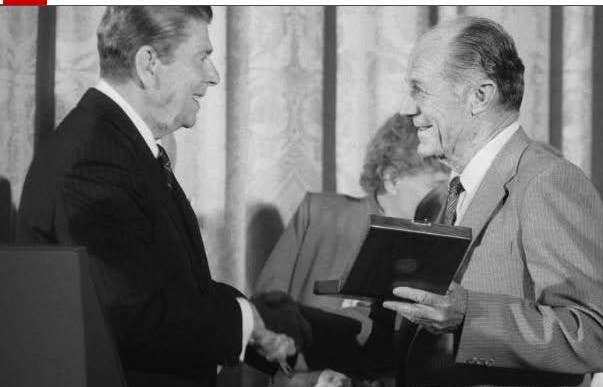Chuck Yeager Postage Stamp Campaign Underway
If you would like to see the aviation legend known as the fastest man alive stamped on your letters, here’s what you can do.

President Ronald Reagan and Chuck Yeager. [Courtesy Victoria Yeager]
How would you like to send a letter with the help of aviation notable Chuck Yeager?
It may be possible in the near future, thanks to a movement underfoot to place the likeness of the brigadier general and test pilot on a postage stamp.
The campaign is being led by Allen Holder, Yeager Airport (KCRW) board member from Lincoln County, West Virginia—the birthplace of the famous aviator and his second wife, Victoria.
"Letters should be addressed to the Citizens' Stamp Advisory Committee but can be sent to Allen Holder," Yeager told FLYING. Campaign organizers plan to bring the letters to the committee as one large package next fall.
Letters should be addressed to:
Attn: Citizens' Stamp Advisory Committee
475 L'Enfant Plaza SW, Room 3300
Washington, DC 20260-3501
Mail the letters to:
General Chuck Yeager Legacy Foundation
PO Box 1146
Grass Valley, CA 95945
An Aviation Legend
Charles Elwood Yeager was born on February 13, 1923, in Lincoln County, West Virginia. His aviation career began in 1941 when he enlisted in the U.S. Army Air Force. Too young to be considered for pilot training, he became a mechanic, but would enter flight training a year later.
During World War II, he flew P-51s on the western front. He was shot down once, evaded capture, and returned to his unit—and demanded to be sent back into combat again. In 1944 he shot down five enemy aircraft in one day.
After WWII, he became a test pilot and is perhaps best remembered for breaking the sound barrier on October 14, 1947, while flying the experimental Bell X-1 at Mach 1.
His career would include various positions of leadership and service, including a term as commandant of the USAF Aerospace Research Pilot School, and serving with the Air Force through Vietnam. He flew more than 360 different types of aircraft in 70 years. After retirement, he continued to fly and act as a consultant to the USAF.
U.S. presidents often called upon his expertise. President Ronald Reagan, for example, appointed him to the committee investigating the explosion of the space shuttle Challenger.
Outside of aviation, Yeager was known as an avid outdoorsman, as he enjoyed fishing and hiking. It was during a hike in Nevada County in 2000 that he met Victoria, who became his second wife.
Yeager was also an author and appeared in movies and documentaries. In 1983 he had a cameo appearance in the feature film The Right Stuff, playing the bartender at the Happy Bottom Riding Club, a bar owned by Yeager's good friend and legendary aviatrix Pancho Barnes. The bar was located at Barnes' resort next to Edwards Air Force Base, where many of the test flights that led to the space program were launched. Test pilots and astronauts frequently visited the club.
In 2009, Yeager was interviewed as part of a documentary on Pancho Barnes. The documentary won an Emmy Award. Yeager died on December 7, 2020, at the age of 97.
Stamp Campaign
According to Victoria Yeager, the grassroots campaign to get the famous flier on a stamp is gaining momentum.
"Lots of people are keen to write the letter," she told FLYING. "We’ve already gotten a few, and we have two resolutions—one from Lincoln County, for Gen. Yeager was born in West Virginia, and the other from Yeager Airport in Charleston, West Virginia. Senator Manchin is keenly supporting the efforts," she said. "One of the letters so far is from Rear Admiral (ret.) Rick 'Hercules' Grant, whom the main character of 'JAG,' the TV series, is based."
Yeager noted that it has been suggested that Gen. Yeager's likeness grace stamps used for Express Mail, as he was known as the fastest man alive for a long time after he broke the sound barrier.
The practice of putting famous Americans on postage stamps goes back to 1934 when President Franklin D. Roosevelt, an avid stamp collector, approved stamps to honor extraordinary and enduring contributions to American society, history, culture or the environment. During his presidency Roosevelt took a personal interest in the process which included selecting the honorees and approving the artwork.

Subscribe to Our Newsletter
Get the latest FLYING stories delivered directly to your inbox






